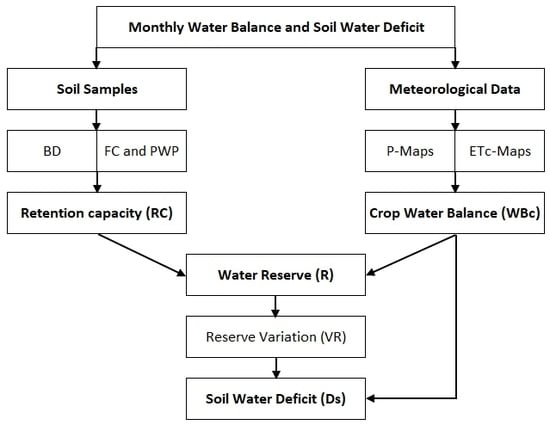Water Balance and Soil Moisture Deficit of Different Vegetation Units under Semiarid Conditions in the Andes of Southern Ecuador
Abstract
1. Introduction
2. Study Area and Data
2.1. Study Area
2.2. Data and Materials
3. Methods
3.1. Soil Sampling and Granulometric Analysis
3.2. Soil Water Retention Capacity (RC)
3.3. Water Balance (WB)
3.3.1. Precipitation (P) Maps
3.3.2. Reference Evapotranspiration (ET0) Maps
3.4. Specific Crop Evapotranspiration (ETc) and Water Balance (WBc)
3.5. Soil Water Reserve (R) and Soil Moisture Deficit (Ds)
4. Results
5. Discussion
6. Conclusions
Supplementary Materials
Author Contributions
Funding
Acknowledgments
Conflicts of Interest
References
- Kibblewhite, M.G.; Ritz, K.; Swift, M.J. Soil health in agricultural systems. Philos. Trans. R. Soc. B Biol. Sci. 2007, 363, 685–701. [Google Scholar] [CrossRef] [PubMed]
- Gorrab, A.; Simonneaux, V.; Zribi, M.; Saadi, S.; Baghdadi, N.; Chabaane, Z.L.; Fanise, P. Bare soil hydrological balance model “MHYSAN”: Calibration and validation using SAR moisture products and continuous thetaprobe network measurements over bare agricultural soils (Tunisia). J. Arid. Env. 2017, 139, 11–25. [Google Scholar] [CrossRef]
- Berendse, F.; van Ruijven, J.; Jongejans, E.; Keesstra, S. Loss of plant species diversity reduces soil erosion resistance. Ecosystems 2015, 18, 881–888. [Google Scholar] [CrossRef]
- Du, J.; Shu, J.; Liu, C.; Guo, Y.; Zhang, L. Variation characteristics of reference crop evapotranspiration and its responses to climate change in upstream areas of Yellow River basin. Trans. Chin. Soc. Agric. Eng. 2012, 28, 92–100. [Google Scholar]
- Milliman, J.D.; Farnsworth, K.L.; Jones, P.D.; Xu, K.H.; Smith, L.C. Climatic and anthropogenic factors affecting river discharge to the global ocean, 1951-2000. Glob. Planet. Chang. 2008, 62, 187–194. [Google Scholar] [CrossRef]
- Ochoa-Sánchez, A.; Crespo, P.; Carrillo-Rojas, G.; Sucozhañay, A.; Célleri, R. Actual Evapotranspiration in the High Andean Grasslands: A Comparison of Measurement and Estimation Methods. Front. Earth Sci. 2019, 7, 55. [Google Scholar]
- Rodríguez Camino, E.; Ruggeroni, J.R.P.; Hernández, F.H. Quinto informe de evaluación del IPCC: Bases físicas. Revista Tiempo y Clima 2014, 5, 36–40. [Google Scholar]
- Stocker, T.F.; Qin, D.; Plattner, G.K.; Tignor, M.; Allen, S.K.; Boschung, J.; Nauels, A.; Xia, Y.; Bex, V.; Midgley, P.M. Climate Change 2013: The Physical Science Basis; Cambridge University Press: Cambridge, UK, 2013. [Google Scholar]
- Sahrawat, K.L. How fertile are semi-arid tropical soils? Curr. Sci. 2016, 110, 1671–1674. [Google Scholar] [CrossRef]
- Zhao, G.; Mu, X.; Tian, P.; Wang, F.; Gao, P. Climate changes and their impacts on water resources in semiarid regions: A case study of the Wei River basin, China. Hydrol. Process. 2013, 27, 3852–3863. [Google Scholar] [CrossRef]
- Seckler, D.; Barker, R.; Amarasinghe, U. Water scarcity in the twenty-first century. Int. J. Water Resour. Dev. 1999, 15, 29–42. [Google Scholar] [CrossRef]
- Montgomery, D.R. Soil erosion and agricultural sustainability. PNAS 2007, 104, 13268–13272. [Google Scholar] [CrossRef] [PubMed]
- Castro, L.M.; Calvas, B.; Hildebrandt, P.; Knoke, T. Avoiding the loss of shade coffee plantations: How to derive conservation payments for risk-averse land-users. Agrofor. Syst. 2013, 87, 331–347. [Google Scholar] [CrossRef]
- Kumar Misra, A. Climate change and challenges of water and food security. Int. J. Sustain. Built Env. 2014, 3, 153–165. [Google Scholar] [CrossRef]
- Kijne, J.W.; Barker, R.; Molden, D.J. Water Productivity in Agriculture: Limits and Opportunities for Improvement; Cabi: Oxfordshire, UK, 2003; Volume 1, p. 332. [Google Scholar]
- Ochoa, P.A.; Fries, A.; Mejía, D.; Burneo, J.I.; Ruíz-Sinoga, J.D.; Cerdà, A. Effects of climate, land cover and topography on soil erosion risk in a semiarid basin of the Andes. Catena 2016, 140, 31–42. [Google Scholar] [CrossRef]
- Fereres, E.; Soriano, M.A. Deficit irrigation for reducing agricultural water use. J. Exp. Bot. 2006, 58, 147–159. [Google Scholar] [CrossRef]
- Douglas-Mankin, K.R. Current research in land, water, and agroecosystems: ASABE journals 2017 year in review. Trans. Asabe 2018, 61, 1639–1651. [Google Scholar] [CrossRef]
- Rafiee, V.; Shourian, M. Optimum multicrop-pattern planning by coupling SWAT and the harmony search algorithm. J. Irrig. Drain. Eng. 2016, 142, 04016063. [Google Scholar] [CrossRef]
- Small, E.E.; Kurc, S.A. Tight coupling between soil moisture and the surface radiation budget in semiarid environments: Implications for land-atmosphere interactions. Water Resour. Res. 2003, 39. [Google Scholar] [CrossRef]
- Esquivel-Hernández, G.; Sánchez-Murillo, R.; Birkel, C.; Boll, J. Climate and Water Conflicts Coevolution from Tropical Development and Hydro-Climatic Perspectives: A Case Study of Costa Rica. J. Am. Water Resour. Assoc. 2018, 54, 451–470. [Google Scholar] [CrossRef]
- Tollner, E.W.; Douglas-Mankin, K.R. International watershed technology: Improving water quality and quantity at the local, basin, and regional scales. Trans. Asabe 2017, 60, 1915–1916. [Google Scholar] [CrossRef][Green Version]
- Vivoni, E.R. Spatial patterns, processes and predictions in ecohydrology: Integrating technologies to meet the challenge. Ecohydrology 2012, 5, 235–241. [Google Scholar] [CrossRef]
- Chamba, Y.M.; Capa, D.; Ochoa, P.A. Environmental characterization and potential zoning for coffee production in the Andes of southern Ecuador. In Proceedings of the 21st Century Watershed Technology Conference and Workshop 2016: Improving Quality of Water Resources at Local, Basin and Regional Scales, Quito, Ecuador, 3–9 December 2016. [Google Scholar]
- Gutiérrez Jurado, H.A.; Vivoni, E.R.; Cikoski, C.; Harrison, J.B.; Bras, R.L.; Istanbulluoglu, E. On the observed ecohydrologic dynamics of a semiarid basin with aspect-delimited ecosystems. Water Resour. Res. 2013, 49, 8263–8284. [Google Scholar] [CrossRef]
- Pierini, N.A.; Vivoni, E.R.; Robles-Morua, A.; Scott, R.L.; Nearing, M.A. Using observations and a distributed hydrologic model to explore runoff thresholds linked with mesquite encroachment in the Sonoran Desert. Water Resour. Res. 2014, 50, 8191–8215. [Google Scholar] [CrossRef]
- Schreiner-McGraw, A.P.; Vivoni, E.R.; Mascaro, G.; Franz, T.E. Closing the water balance with cosmic-ray soil moisture measurements and assessing their relation to evapotranspiration in two semiarid watersheds. Hydrol. Earth Syst. Sci. 2016, 20, 329. [Google Scholar] [CrossRef]
- Bahr, E.; Chamba-Zaragocin, D.; Makeschin, F. Soil nutrient stock dynamics and land-use management of annuals, perennials and pastures after slash-and-burn in the Southern Ecuadorian Andes. Agric. Ecosyst. Env. 2014, 188, 275–288. [Google Scholar] [CrossRef]
- De Cambio Climático, S. República del Ecuador; Subsecretaría de Cambio Climático: Quito, Ecuador, 2015. [Google Scholar]
- Fries, A.; Rollenbeck, R.; Bayer, F.; Gonzalez, V.; Valivieso, F.O.; Peters, T.; Bendix, J. Catchment precipitation processes in the San Francisco valley in southern Ecuador: Combined approach using high-resolution radar images and in situ observations. Meteorol. Atmos. Phys. 2014, 126, 13–29. [Google Scholar] [CrossRef]
- Ochoa, P.A.; Chamba, Y.M.; Arteaga, J.G.; Capa, E.D. Estimation of suitable areas for coffee growth using a GIS approach and multicriteria evaluation in regions with scarce data. Appl. Eng. Agric. 2017, 33, 841–848. [Google Scholar] [CrossRef]
- Oñate Valdivieso, F.; Naranjo, G.A. Aplicación del modelo SWAT para la estimación de caudales y sedimentos en la cuenca alta del rio Catamayo. In Proceedings of the Tercer Congreso Latinoamericano de Manejo de Cuencas Hidrográfica, AREQUIPA, PERÚ, 9–13 July 2003. [Google Scholar]
- SENAGUA. Secretaría Nacional del Agua. Caracterización conceptual y metodológica enfocado al ordenamiento territorial como parte del Plan Nacional de Recursos Hídricos; Plan Nacional de Recursos Hídricos (PNRH): Quito, Ecuador, 2011. [Google Scholar]
- Lipton, M.; Litchfield, J.; Faurès, J.M. The effects of irrigation on poverty: A framework for analysis. Water Policy Off. J. World Water Counc. 2003, 5, 413–427. [Google Scholar] [CrossRef]
- Pineda Martínez, L.F.; Chairez, F.G.E.; Wilson, J.G.B.; Almaraz, L.J.B. Análisis de la producción agrícola del DDR189 de la región semiárida en Zacatecas, México. Agrociencia 2013, 47, 181–193. [Google Scholar]
- Abbas, A.; Khan, S.; Hussain, N.; Hanjra, M.A.; Akbar, S. Characterizing soil salinity in irrigated agriculture using a remote sensing approach. Phys. Chem. EarthParts A/B/C 2013, 55, 43–52. [Google Scholar] [CrossRef]
- Reinoso Acaro, M.; Condolo, J.L.J. Determinar los requerimientos hídricos de pimiento (Capsicum Annuum), mediante el lisímetro volumétrico, en el sector San José perteneciente al sistema de riego Campana-Malacatos; Bachelor-UTPL: Loja, Ecuador, 2017. [Google Scholar]
- Bendix, J.; Fries, A.; Zárate, J.; Trachte, K.; Rollenbeck, R.; Cofrep, F.P.; Paladines, R.; Palacios, I.; Orellana, J.; Valdivieso, F.O. RadarNet-Sur first weather radar network in tropical high mountains. Bull. Am. Meteorol. Soc. 2017, 98, 1235–1254. [Google Scholar] [CrossRef]
- Oñate Valdivieso, F.; Fries, A.; Mendoza, K.; Jaramillo, V.G.; Cofrep, F.P.; Rollenbeck, R.; Bendix, J. Temporal and spatial analysis of precipitation patterns in an Andean region of southern Ecuador using LAWR weather radar. Meteorol. Atmos. Phys. 2018, 130, 473–484. [Google Scholar] [CrossRef]
- Tamay, J.; Galindo-Zaldívar, J.; Ruano, P.; Soto, J.; Lamas, F.; Azañón, J.M. New insight on the recent tectonic evolution and uplift of the southern Ecuadorian Andes from gravity and structural analysis of the Neogene-Quaternary intramontane basins. J. South Am. Earth Sci. 2016, 70, 340–352. [Google Scholar] [CrossRef]
- Fries, A.; Rollenbeck, R.; Göttlicher, D.; Nauss, T.; Homeier, J.; Peters, T.; Bendix, J. Thermal structure of a megadiverse Andean mountain ecosystem in southern Ecuador and its regionalization. Erdkunde 2009, 63, 321–335. [Google Scholar] [CrossRef]
- Correa-Quezada, R.; García-Vélez, D.F.; del Río-Rama, M.C.; Álvarez-García, J. Poverty Traps in the Municipalities of Ecuador: Empirical Evidence. Sustainability 2018, 10, 4316. [Google Scholar] [CrossRef]
- Ministerio del Ambiente del Ecuador. Sistema de clasificación de los ecosistemas del Ecuador continental; Subsecretaria de Patrimonio Natural: Quito, Ecuador, 2013. [Google Scholar]
- Flores-López, F.; Galaitsi, S.E.; Escobar, M.; Purkey, D. Modeling of Andean páramo ecosystems hydrological response to environmental change. Water 2016, 8, 94. [Google Scholar] [CrossRef]
- González-Jaramillo, V.; Fries, A.; Zeilinger, J.; Homeier, J.; Paladines-Benitez, J.; Bendix, J. Estimation of above ground biomass in a tropical mountain forest in southern Ecuador using airborne LIDAR data. Remote Sens. 2018, 10, 660. [Google Scholar] [CrossRef]
- Cabrera, O.; Fries, A.; Hildebrandt, P.; Günter, S.; Mosandl, R. Early Growth Response of Nine Timber Species to Release in a Tropical Mountain Forest of Southern Ecuador. Forests 2019, 10, 254. [Google Scholar] [CrossRef]
- Ochoa-Cueva, P.; Fries, A.; Montesinos, P.; Rodríguez-Díaz, J.A.; Boll, J. Spatial Estimation of Soil Erosion Risk by Land-cover Change in the Andes OF Southern Ecuador. Land Degrad. Dev. 2015, 26, 565–573. [Google Scholar] [CrossRef]
- González Jaramillo, V.; Fries, A.; Rollenbeck, R.; Paladines, J.; Valdivieso, F.O.; Bendix, J. Assessment of deforestation during the last decades in Ecuador using NOAA-AVHRR satellite data. Erdkunde 2016, 70, 217–235. [Google Scholar] [CrossRef]
- WRB, IUSS Working Group. World Reference Base for Soil Resources 2014, update 2015. In International soil classification system for naming soils and creating legends for soil maps; World Soil Resources Reports; FAO: Rome, Spain, 2015. [Google Scholar]
- Al-Shammary, A.A.G.; Kouzani, A.Z.; Kaynak, A.; Khoo, S.Y.; Norton, M.; Gates, W. Soil bulk density estimation methods: A Review. Pedosphere 2018, 28, 581–596. [Google Scholar] [CrossRef]
- Mejía-Veintimilla, D.; Ochoa-Cueva, P.; Samaniego-Rojas, N.; Félix, R.; Arteaga, J.G.; Crespo, P.; Oñate-Valdivieso, F.; Fries, A. River Discharge Simulation in the High Andes of Southern Ecuador Using High-Resolution Radar Observations and Meteorological Station Data. Remote Sens. 2019, 11, 2804. [Google Scholar] [CrossRef]
- Keesstra, S.; Pereira, P.; Novara, A.; Brevik, E.C.; Azorin-Molina, C.; Parras-Alcántara, L.; Jordán, A.; Cerdà, A. Effects of soil management techniques on soil water erosion in apricot orchards. Sci. Total Env. 2016, 551, 357–366. [Google Scholar] [CrossRef] [PubMed]
- Shaibu, A.; Kranjac-Berisavljevic, G.; Nyarko, G. Soil Physical and Chemical Properties and Crop Water Requirement of Some Selected Vegetable Crops at Central Experimental Field of Urban Food Plus Project in Sanarigu District, Tamale, Ghana. Ghana J. Sci. Technol. Dev. 2017, 5, 14–25. [Google Scholar]
- Lampurlanés, J.; Cantero, M. Soil bulk density and penetration resistance under different tillage and crop management systems and their relationship with barley root growth. Agron. J. 2003, 95, 526–536. [Google Scholar] [CrossRef]
- Gabriels, D.; Lobo, D. Métodos para determinar granulometría y densidad aparente del suelo. Venesuelos 2011, 14, 37–48. [Google Scholar]
- Poeplau, C.; Vos, C.; Don, A. Soil organic carbon stocks are systematically overestimated by misuse of the parameters bulk density and rock fragment content. Soil 2017, 3, 61–66. [Google Scholar] [CrossRef]
- Soil, K. Soil Survey Laboratory methods manual, Soil survey investigations report; National Soil Survey Center, Soil Conservation Service, U.S. Department of Agriculture: DepLincoln, NE, USA, 2004.
- Velasquez Valencia, H.; Menjivar, J.C.; Escobar, C.A. Identificación de suelos susceptibles a riesgos de erosión y con mayor capacidad de almacenamiento de agua. Acta Agronómica 2007, 56, 117–125. [Google Scholar]
- Amézquita, C.E. El agua y la erodabilidad de los suelos; Fundamentos para la Interpretación de Análisis de Suelos, Plantas y Aguas para riego; Sociedad Colombiana de la Ciencia del Suelo: Bogota, Colombia, 1995; Volume 128, pp. 128–136. [Google Scholar]
- Hillel, D. Environmental Soil Physics; Fundamentals, applications, and environmental considerations; Academic Press: San Diego, CA, USA, 1998. [Google Scholar]
- Jian, S.; Zhao, C.; Fang, S.; Yu, K. Effects of different vegetation restoration on soil water storage and water balance in the Chinese Loess Plateau. Agric. Meteorol. 2015, 206, 85–96. [Google Scholar] [CrossRef]
- Coral, A.C.; Tommaselli, J.T.G.; Leal, A.C. Cálculo de balance hídrico usando modelamiento de datos espaciales: Estudio aplicado a la cuenca del río Buena Vista, Ecuador. Formação 2015, 1, 119–137. [Google Scholar]
- Durre, I.; Menne, M.J.; Gleason, B.E.; Houston, T.G.; Vose, R.S. Comprehensive automated quality assurance of daily surface observations. J. Appl. Meteorol. Climatol. 2010, 49, 1615–1633. [Google Scholar] [CrossRef]
- Mmbando, G.; Kleyer, M. Mapping Precipitation, Temperature, and Evapotranspiration in the Mkomazi River Basin, Tanzania. Climate 2018, 6, 63. [Google Scholar] [CrossRef]
- Blaney, H.F.; Criddle, W.D. Determining Consumptive use and Irrigation Water Requirements; US Department of Agriculture: Washington, DC, USA, 1962.
- Subedi, A.; Chávez, J.L. Crop evapotranspiration (ET) estimation models: A review and discussion of the applicability and limitations of ET methods. J. Agric. Sci. 2015, 7, 50. [Google Scholar] [CrossRef]
- Barnett, N.; Madramootoo, C.A.; Perrone, J. Performance of some evapotranspiration. Can Agric Eng 1998, 40, 89. [Google Scholar]
- Cuenca, R.H. Irrigation system design. An engineering approach; Prentice Hall: Upper Saddle River, NJ, USA, 1989; p. 552. [Google Scholar]
- Kattel, D.B.; Yao, T. Temperature-topographic elevation relationship for high mountain terrain: An example from the southeastern Tibetan Plateau. Int. J. Clim. 2018, 38, e901–e920. [Google Scholar] [CrossRef]
- Weng, Q.; Firozjaei, M.K.; Kiavarz, M.; Alavipanah, S.K.; Hamzeh, S. Normalizing land surface temperature for environmental parameters in mountainous and urban areas of a cold semi-arid climate. Sci. Total Env. 2019, 650, 515–529. [Google Scholar] [CrossRef]
- Fries, A.; Rollenbeck, R.; Nauß, T.; Peters, T.; Bendix, J. Near surface air humidity in a megadiverse Andean mountain ecosystem of southern Ecuador and its regionalization. Agric. For. Meteorol. 2012, 152, 17–30. [Google Scholar] [CrossRef]
- Brouwer, C.; Heibloem, M. Irrigation water management: Irrigation water needs. Train. Man. 1986, 3. [Google Scholar]
- Hafeez, M.; Khan, A.A. Assessment of Hargreaves and Blaney-Criddle Methods to Estimate Reference Evapotranspiration Under Coastal Conditions. Am. J. Sci. Eng. Technol. 2019, 3, 65. [Google Scholar]
- Allen, R.G.; Pereira, L.S.; Raes, D.; Smith, M. Crop evapotranspiration-Guidelines for computing crop water requirements. Fao Irrig. Drain. 1998, 56, D05109. [Google Scholar]
- Novoa, P. Estimación de la evapotranspiración actual en bosques: Teoría. Bosque 1998, 19, 111–121. [Google Scholar] [CrossRef]
- Wang, K.; Dickinson, R.E. A review of global terrestrial evapotranspiration: Observation, modeling, climatology, and climatic variability. Rev. Geophys. 2012, 50. [Google Scholar] [CrossRef]
- Silva, B.; Núñez, P.Á.; Strobl, S.; Beck, E.; Bendix, J. Area-wide evapotranspiration monitoring at the crown level of a tropical mountain rain forest. Remote Sens. Environ. 2017, 194, 219–229. [Google Scholar] [CrossRef]
- Fernández Long, M.E.; Spescha, L.; Barnatán, I.; Murphy, G. Modelo de balance hidrológico operativo para el agro (BHOA). Rev. Fac. De Agron. Uba 2012, 32, 31–47. [Google Scholar]
- Fleischbein, K.; Wilcke, W.; Valarezo, C.; Zech, W.; Knoblich, K. Water budgets of three small catchments under montane forest in Ecuador: Experimental and modelling approach. Hydrol. Process. 2006, 20, 2491–2507. [Google Scholar] [CrossRef]
- Wohl, E.; Barros, A.; Brunsell, N.; Chappell, N.A.; Coe, M.l.; Giambelluca, T.; Goldsmith, S.; Harmon, R.; Hendrickx, J.M.H.; Juvik, J.; et al. The hydrology of the humid tropics. Nat. Clim. Chang. 2012, 2, 655. [Google Scholar] [CrossRef]
- Quintal Ortiz, W.C.; Pérez Gutiérrez, A.; Latournerie Moreno, L.; Lara, C.M.; Sánchez, E.R.; Chacón, A.J.M. Uso de agua, potencial hídrico y rendimiento de chile habanero (Capsicum chinense Jacq.). Rev. Fitotec. Mex. 2012, 32, 155–160. [Google Scholar]
- Pérez Cutillas, P.; Barberá, G.G.; García, C.C. Estimación de la humedad del suelo a niveles de capacidad de campo y punto de marchitez mediante modelos predictivos a escala regional. BAGE 2015, 68, 325–345. [Google Scholar]
- Ruiz Álvarez, O.; Ramírez, R.A.; Peña, M.A.V.; Capurata, R.E.O.; López, R.L. Balance hídrico y clasificación climática del estado de Tabasco, México. Univ. Y Cienc. 2012, 28, 1–14. [Google Scholar]
- Leung, A.K.; Garg, A.; Ng, C.W.W. Effects of plant roots on soil-water retention and induced suction in vegetated soil. Eng. Geol. 2015, 193, 183–197. [Google Scholar] [CrossRef]
- Johannes, A.; Matter, A.; Schulin, R.; Weisskopf, P.; Baveye, P.C.; Boivin, P. Optimal organic carbon values for soil structure quality of arable soils. Does clay content matter? Geoderma 2017, 302, 14–21. [Google Scholar] [CrossRef]
- Allen, R.G.; Pereira, L.S.; Smith, M.; Raes, D.; Wright, J.L. FAO-56 dual crop coefficient method for estimating evaporation from soil and application extensions. J. Irrig. Drain. Eng. 2005, 131, 2–13. [Google Scholar] [CrossRef]
- Bendix, J.; Rollenbeck, R.; Göttlicher, D.; Cermak, J. Cloud occurrence and cloud properties in Ecuador. Clim. Res. 2006, 30, 133–147. [Google Scholar] [CrossRef]
- Célleri, R.; Feyen, J. The hydrology of tropical Andean ecosystems: Importance, knowledge status, and perspectives. Mt. Res. Dev. 2009, 29, 350–356. [Google Scholar] [CrossRef]
- Vale Scarpare, F.; Hernandes, T.A.D.; Ruiz-Corrêa, S.T.; Picoli, M.C.A.; Scanlon, B.R.; Chagas, M.F.; Duft, D.G.; de Fátima Cardoso, T. Sugarcane land use and water resources assessment in the expansion area in Brazil. J. Clean. Prod. 2016, 133, 1318–1327. [Google Scholar] [CrossRef]
- Hossne García, A.J.; Jaime, Y.N.M.; Bastardo, L.D.S.; Llovera, F.A.S.; Contreras, A.M.Z. Humedad compactante y sus implicaciones agrícolas en dos suelos franco arenoso de sabana del estado Monagas, Venezuela. Revista Científic UDO Agrícola 2009, 9, 937–950. [Google Scholar]
- Rivadeneira Vera, J.F.; Mera, Y.E.Z.; Pérez-Martín, M.A. Adapting water resources systems to climate change in tropical areas: Ecuadorian coast. Sci. Total Env. 2019, 703, 135554. [Google Scholar] [CrossRef]
- Thornthwaite, C.W. An approach toward a rational classification of climate. Geogr. Rev. 1948, 38, 55–94. [Google Scholar] [CrossRef]
- Kite, G. Land Surface Parameterizations of GCMs and Macroscale Hydrological Models. J. Am. Water Resour. Assoc. 1998, 34, 1247–1254. [Google Scholar] [CrossRef]
- Gerten, D.; Schaphoff, S.; Haberlandt, U.; Lucht, W.; Sitch, S. Terrestrial vegetation and water balance—hydrological evaluation of a dynamic global vegetation model. J. Hydrol. 2004, 286, 249–270. [Google Scholar] [CrossRef]
- Chen, H.; Huo, Z.; Dai, X.; Ma, S.; Xu, X.; Huang, G. Impact of agricultural water-saving practices on regional evapotranspiration: The role of groundwater in sustainable agriculture in arid and semi-arid areas. Agric. For. Meteorol. 2018, 263, 156–168. [Google Scholar] [CrossRef]
- SENAGUA. Caracteriación conceptual y metodológica enfocado al ordenamiento territorial, como parte del Plan Nacional de Recursos Hídricos. In Bases para el análisis territorial del ciclo hidrológico; Plan Nacional de Recursos Hídricos (PNRH), Ed.; Secretaria Nacional del Agua (SENAGUA): Quito, Ecuador, 2011. [Google Scholar]
- Jalilvand, E.; Tajrishy, M.; Hashemi, S.A.G.Z.; Brocca, L. Quantification of irrigation water using remote sensing of soil moisture in a semi-arid region. Remote Sens. Env. 2019, 231, 111226. [Google Scholar] [CrossRef]
- Martínez-Paz, J.M.; Gomariz-Castillo, F.; Pellicer-Martínez, F. Appraisal of the water footprint of irrigated agriculture in a semi-arid area: The Segura River Basin. PLoS ONE 2018, 13, e0206852. [Google Scholar] [CrossRef]
- FAO. Assessment, Global Forest Resource: Main report. Available online: www.fao.org/forestry/fra/en/ (accessed on 22 April 2019).
- Manchego, C.E.; Hildebrandt, P.; Cueva, J.; Espinosa, C.I.; Stimm, B.; Günter, S. Climate change versus deforestation: Implications for tree species distribution in the dry forests of southern Ecuador. PLoS ONE 2017, 12, e0190092. [Google Scholar] [CrossRef] [PubMed]
- Valdez, F. Agricultura ancestral camellones y albarradas: contexto social, usos y retos del passado y del presente: coloquio agricultura prehispánica sistemas basados en el drenaje y en la elevación de los suelos cultivados; Instituto Francés de Estudios Andinos: Fondo Editorial Pontificia Universidad Católica del Perú: Paris, France, 2006. [Google Scholar]
- Recha, J.W.; Mati, B.M.; Nyasimi, M.; Kimeli, P.K.; Kinyangi, J.M.; Radeny, M. Changing rainfall patterns and farmers’ adaptation through soil water management practices in semi-arid eastern Kenya. Arid Land Res. Manag. 2016, 30, 229–238. [Google Scholar] [CrossRef]
- Team, C.W.; Pachauri, R.K.; Meyer, L.A. IPCC, 2014: Climate Change 2014: Synthesis Report. Contribution of Working Groups I, II and III to the Fifth Assessment Report of the intergovernmental panel on Climate Change; IPCC: Geneva, Switzerland, 2014; p. 151. [Google Scholar]
- Ministerio del Ambiente del Ecuador. Tercera Comunicación Nacional del Ecuador a la Convención Marco de las Naciones Unidas sobre el Cambio Climático; Tercera Comunicación Nacional del Ecuador sobre Cambio Climático: Quito, Ecuador, 2017; p. 603. [Google Scholar]
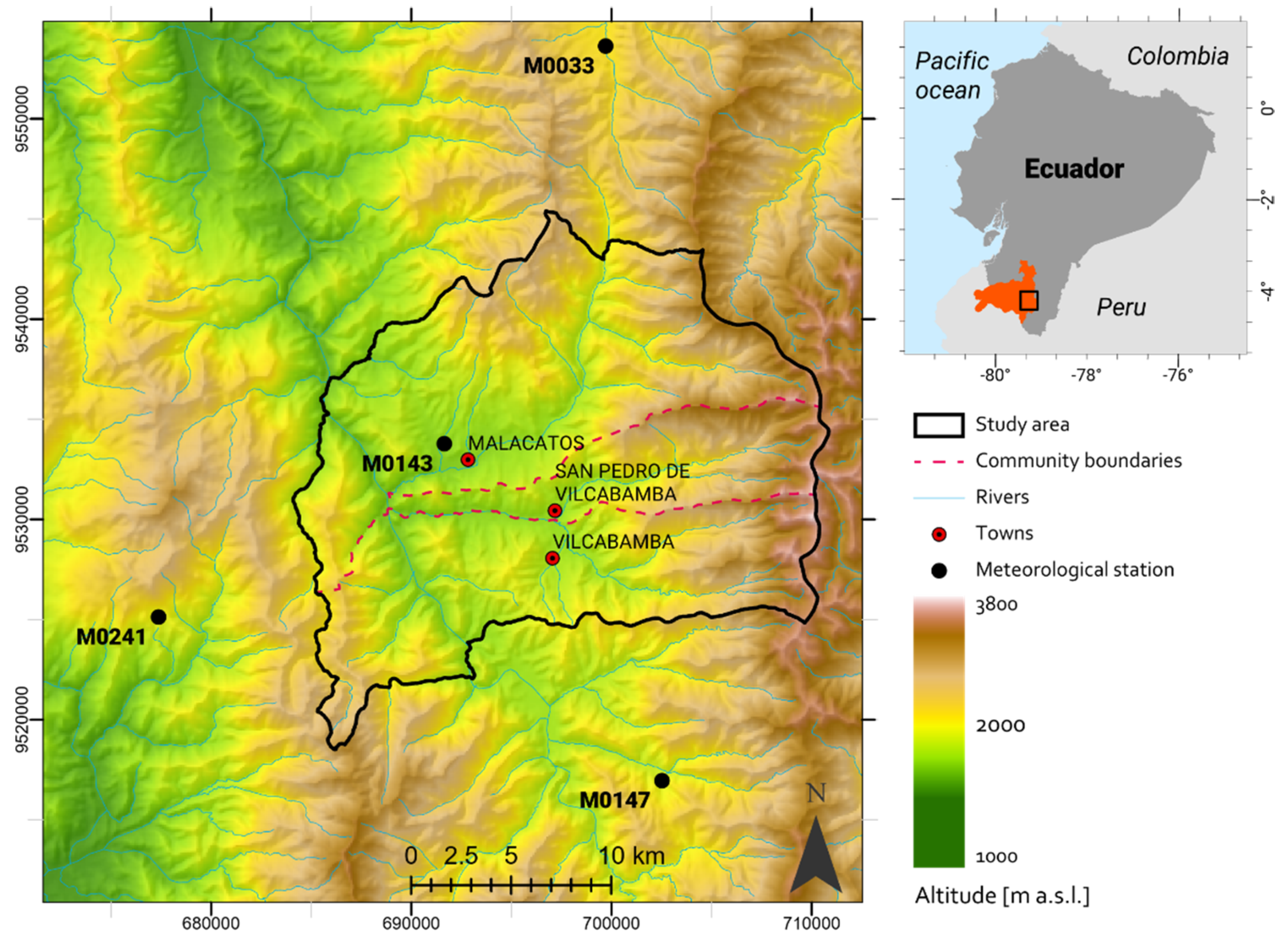
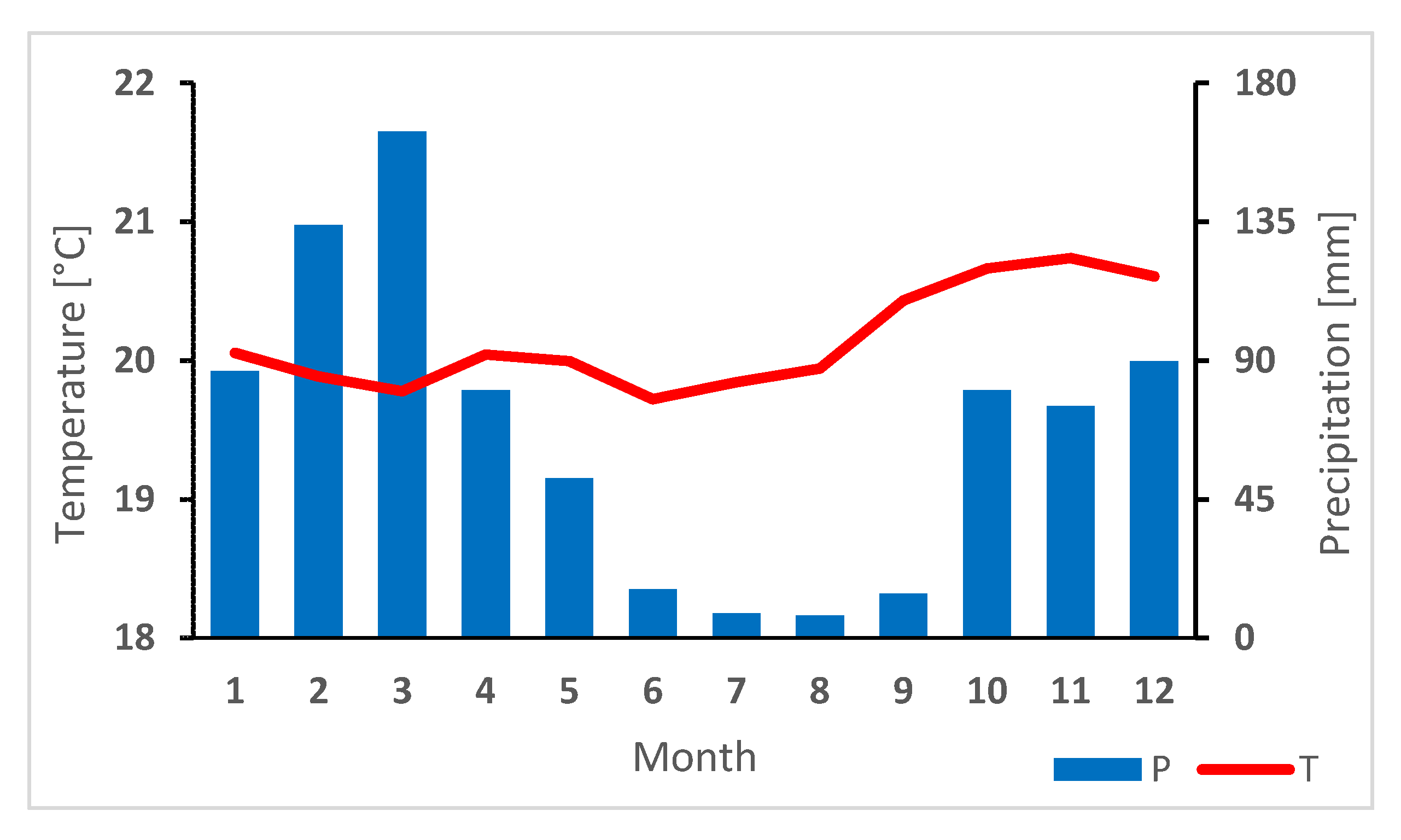
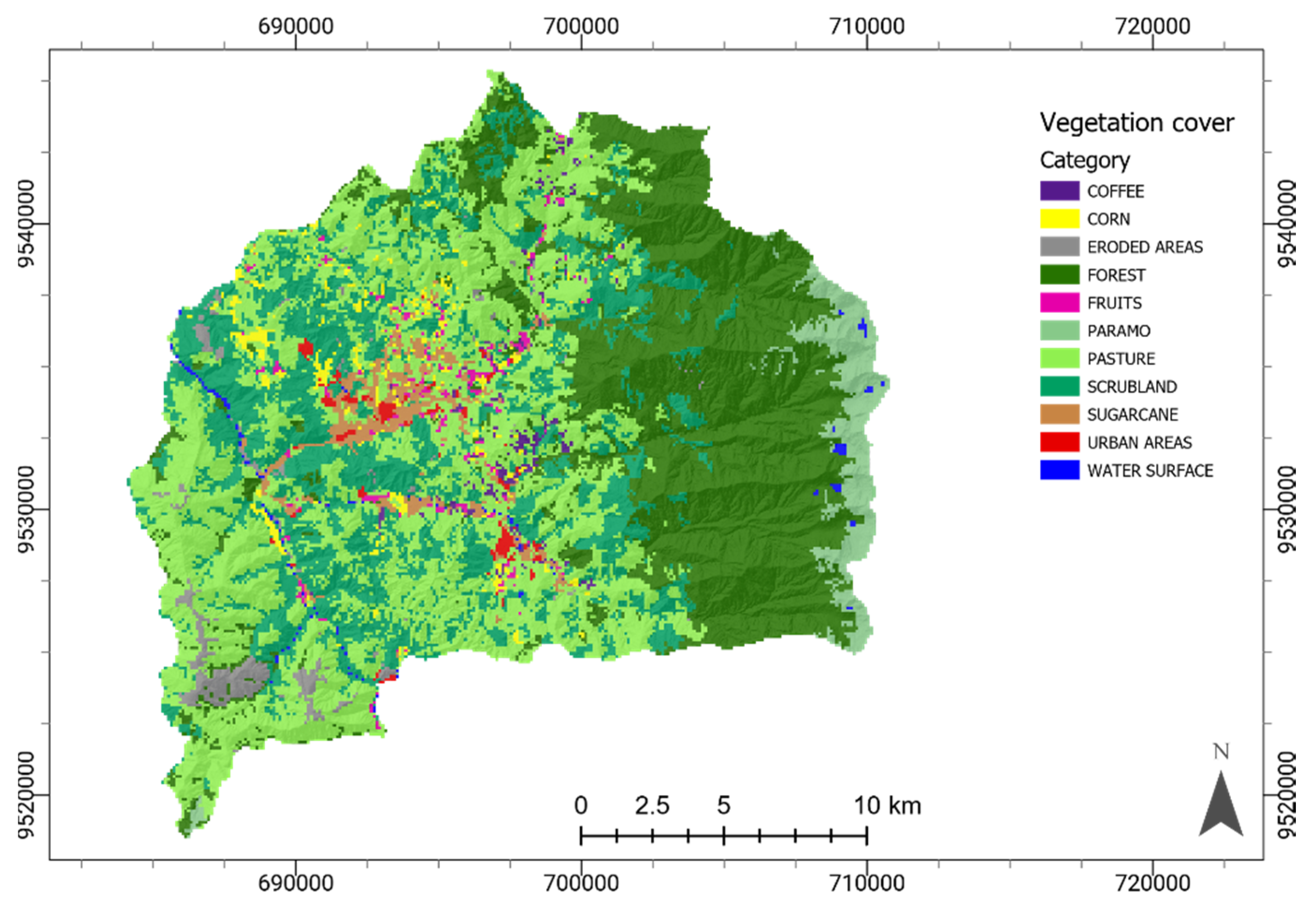
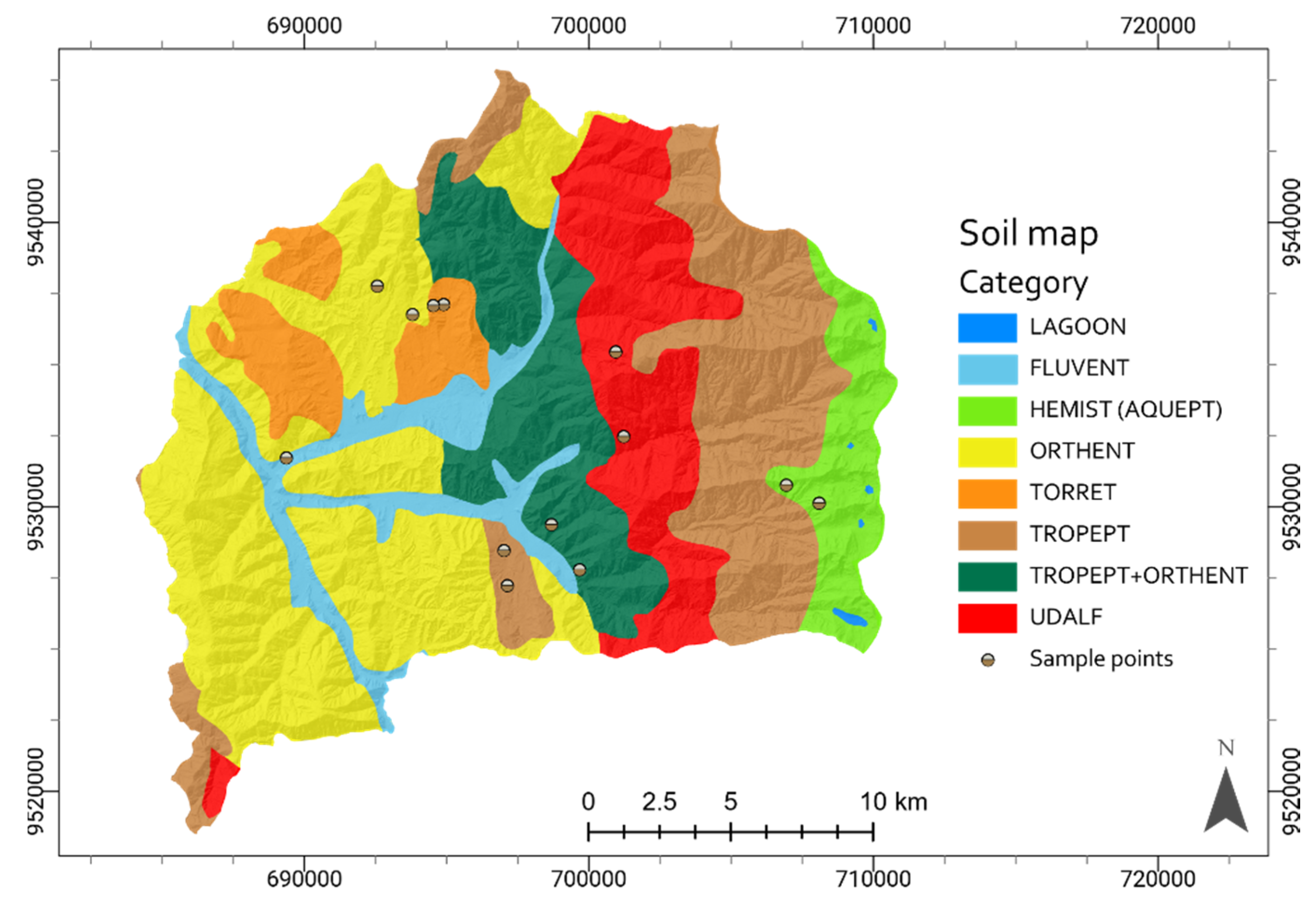

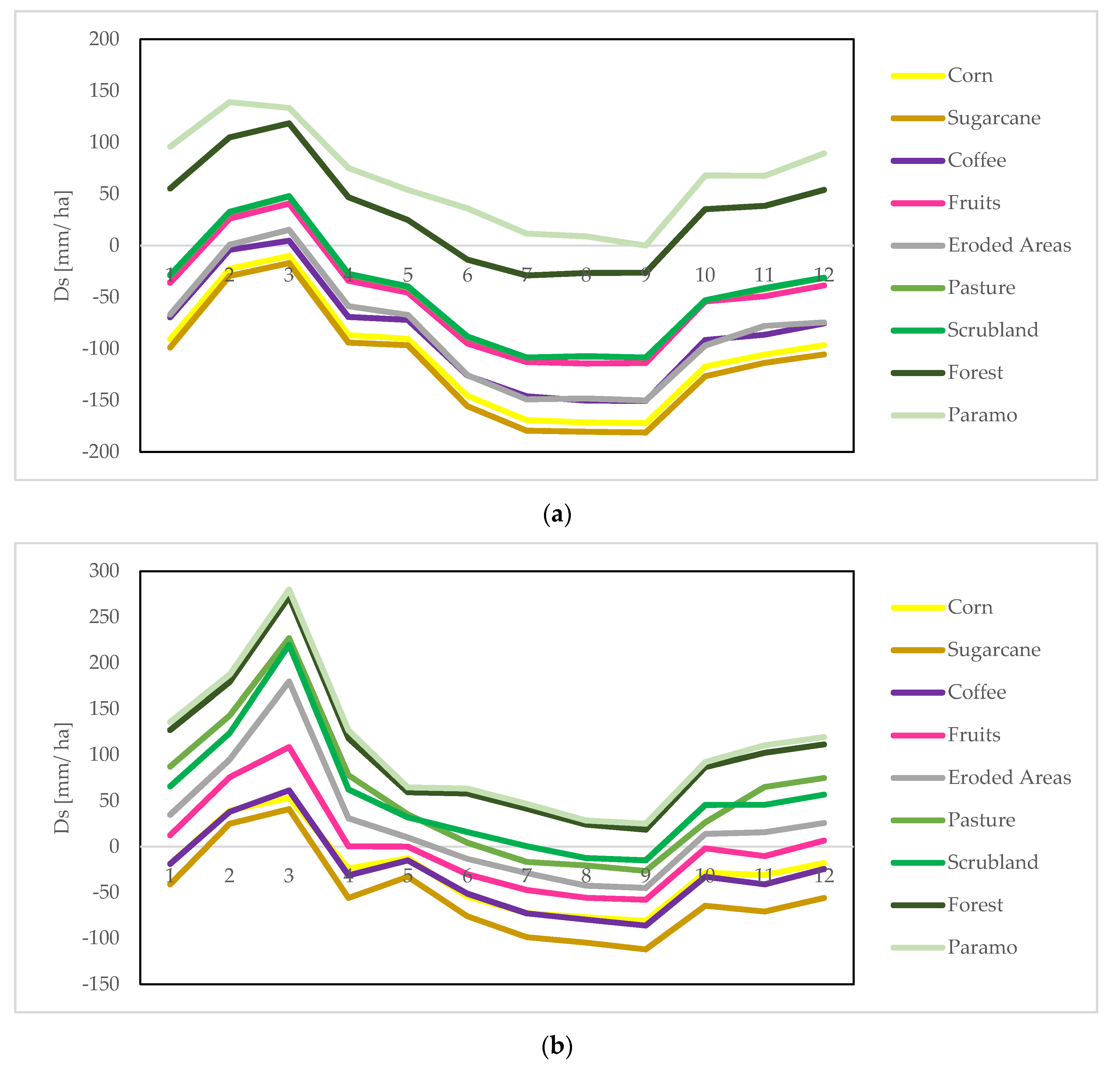
| Category | Kc |
|---|---|
| Corn | 1.15 |
| Fruits | 0.80 |
| Water Surface | 1.05 |
| Sugar cane | 1.20 |
| Coffee | 1.05 |
| Pasture | 0.75 |
| Eroded Areas | 1.00 |
| Shrubland | 0.75 |
| Forest | 0.25 |
| Urban areas | 1.00 |
| Paramo | 0.15 |
| SOIL TYPE | SAND (%) | LOAM (%) | CLAY (%) | Da (g/cm3) | CC (%) | PWP (%) | RC (mm) |
|---|---|---|---|---|---|---|---|
| Fluvent | 66.87 | 14.67 | 18.46 | 1.48 | 15.40 | 8.05 | 32.65 |
| Udalf | 46.65 | 22.35 | 31.01 | 1.48 | 22.20 | 12.33 | 43.62 |
| Orthent | 71.03 | 12.80 | 16.18 | 1.29 | 14.09 | 7.24 | 26.87 |
| Hemist | 52.92 | 22.42 | 24.67 | 1.44 | 19.31 | 10.51 | 37.98 |
| Tropept + Orthent | 38.19 | 22.94 | 77.74 | 1.42 | 25.87 | 14.64 | 47.94 |
| Tropept | 28.69 | 31.79 | 39.53 | 1.57 | 27.40 | 15.60 | 55.09 |
| Torret | 49.80 | 19.33 | 30.88 | 1.30 | 21.72 | 12.03 | 37.56 |
| Landcover | CORN | SUGARCANE | COFFEE | FRUITS | PASTURE | ERODED AREAS | SCRUBLAND | FOREST | PARAMO | |||||||||
|---|---|---|---|---|---|---|---|---|---|---|---|---|---|---|---|---|---|---|
| Ds [mm] | Min | Max | Min | Max | Min | Max | Min | Max | Min | Max | Min | Max | Min | Max | Min | Max | Min | Max |
| Jan | --90.6 | --18.6 | --98.7 | --41.1 | --69.4 | --18.8 | --35.9 | 12.4 | --29.0 | 87.4 | --66.7 | 34.8 | --28.3 | 65.8 | 55.4 | 127.2 | 95.9 | 135.8 |
| Feb | --22.4 | 39.3 | --29.4 | 24.9 | --4.0 | 37.9 | 26.2 | 75.5 | 32.1 | 142.7 | 0.8 | 94.8 | 32.8 | 123.7 | 104.9 | 179.0 | 139.0 | 187.0 |
| Mar | --9.8 | 53.0 | --16.9 | 40.8 | 4.8 | 61.4 | 40.7 | 108.5 | 47.8 | 227.0 | 15.3 | 179.6 | 48.0 | 219.6 | 118.6 | 272.2 | 133.5 | 280.1 |
| Apr | --86.6 | --23.7 | --94.0 | --55.9 | --69.2 | --31.3 | --33.9 | 0.2 | --28.1 | 77.9 | --58.7 | 31.0 | --27.3 | 62.4 | 47.0 | 118.2 | 75.2 | 126.7 |
| May | --90.2 | --12.7 | --96.6 | --32.7 | --72.0 | --15.1 | --45.6 | --0.1 | --40.5 | 35.2 | --67.1 | 9.9 | --39.5 | 31.9 | 24.9 | 59.2 | 54.0 | 64.5 |
| Jun | --145.5 | --54.6 | --155.5 | --75.9 | --125.9 | --51.2 | --94.8 | --30.2 | --88.6 | 4.3 | --125.6 | --13.3 | --87.9 | 16.0 | --13.6 | 58.0 | 36.1 | 63.3 |
| Jul | --169.2 | --72.4 | --179.4 | --98.6 | --145.9 | --72.7 | --112.8 | --47.3 | --108.6 | --16.6 | --149.1 | --28.9 | --108.4 | 0.5 | --29.0 | 41.4 | 11.6 | 46.5 |
| Aug | --171.4 | --77.0 | --180.4 | --104.8 | --150.3 | --79.6 | --114.4 | --55.8 | --107.1 | --20.4 | --148.1 | --42.6 | --107.5 | --12.5 | --26.5 | 24.0 | 9.0 | 28.4 |
| Sep | --172.1 | --80.8 | --181.1 | --112.1 | -150.5 | -86.1 | -113.8 | -58.0 | -108.6 | -26.5 | -150.1 | -45.2 | -108.4 | -15.1 | -26.2 | 18.5 | 0.0 | 25.0 |
| Oct | -117.1 | -28.5 | -126.6 | -64.4 | -91.4 | -32.8 | -54.0 | -1.8 | -53.0 | 26.4 | -96.7 | 13.9 | -52.8 | 45.5 | 35.3 | 86.6 | 67.9 | 92.2 |
| Nov | -105.5 | -30.9 | -113.6 | -70.8 | -86.3 | -41.1 | -49.0 | -10.4 | -42.0 | 65.0 | -77.7 | 15.5 | -41.0 | 45.5 | 38.5 | 102.3 | 67.7 | 110.5 |
| Dec | -96.3 | -17.8 | -105.4 | -56.0 | -75.3 | -24.3 | -38.5 | 6.7 | -31.2 | 74.9 | -74.4 | 25.8 | -31.0 | 56.7 | 54.0 | 111.4 | 89.4 | 119.5 |
| Year | -1276.8 | -324.7 | -1377.6 | -646.5 | -1035.4 | -353.6 | -625.7 | -0.3 | -556.8 | 677.0 | -998.1 | 275.3 | -551.3 | 640.1 | 383.4 | 1198.0 | 779.3 | 1279.6 |
© 2020 by the authors. Licensee MDPI, Basel, Switzerland. This article is an open access article distributed under the terms and conditions of the Creative Commons Attribution (CC BY) license (http://creativecommons.org/licenses/by/4.0/).
Share and Cite
Fries, A.; Silva, K.; Pucha-Cofrep, F.; Oñate-Valdivieso, F.; Ochoa-Cueva, P. Water Balance and Soil Moisture Deficit of Different Vegetation Units under Semiarid Conditions in the Andes of Southern Ecuador. Climate 2020, 8, 30. https://doi.org/10.3390/cli8020030
Fries A, Silva K, Pucha-Cofrep F, Oñate-Valdivieso F, Ochoa-Cueva P. Water Balance and Soil Moisture Deficit of Different Vegetation Units under Semiarid Conditions in the Andes of Southern Ecuador. Climate. 2020; 8(2):30. https://doi.org/10.3390/cli8020030
Chicago/Turabian StyleFries, Andreas, Karen Silva, Franz Pucha-Cofrep, Fernando Oñate-Valdivieso, and Pablo Ochoa-Cueva. 2020. "Water Balance and Soil Moisture Deficit of Different Vegetation Units under Semiarid Conditions in the Andes of Southern Ecuador" Climate 8, no. 2: 30. https://doi.org/10.3390/cli8020030
APA StyleFries, A., Silva, K., Pucha-Cofrep, F., Oñate-Valdivieso, F., & Ochoa-Cueva, P. (2020). Water Balance and Soil Moisture Deficit of Different Vegetation Units under Semiarid Conditions in the Andes of Southern Ecuador. Climate, 8(2), 30. https://doi.org/10.3390/cli8020030





